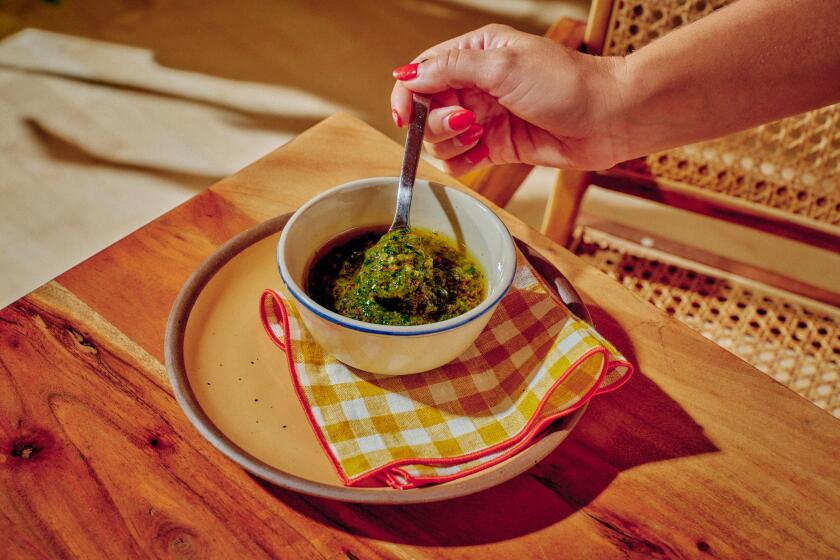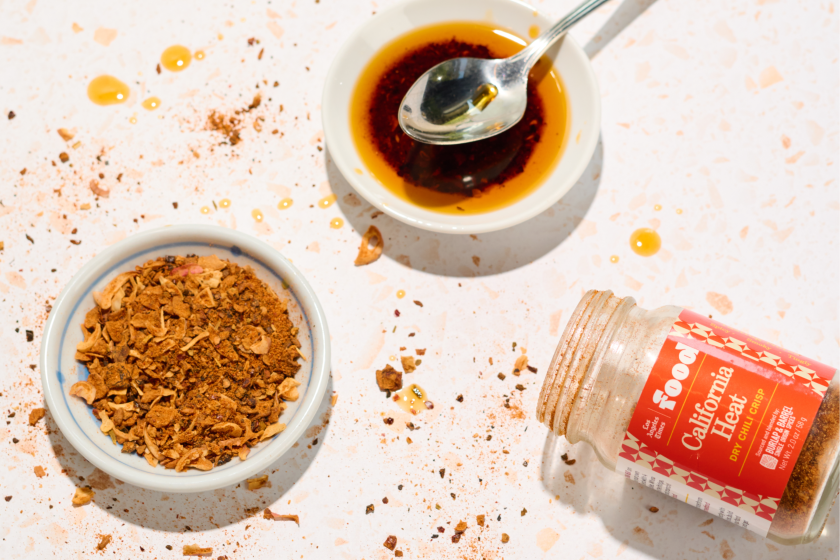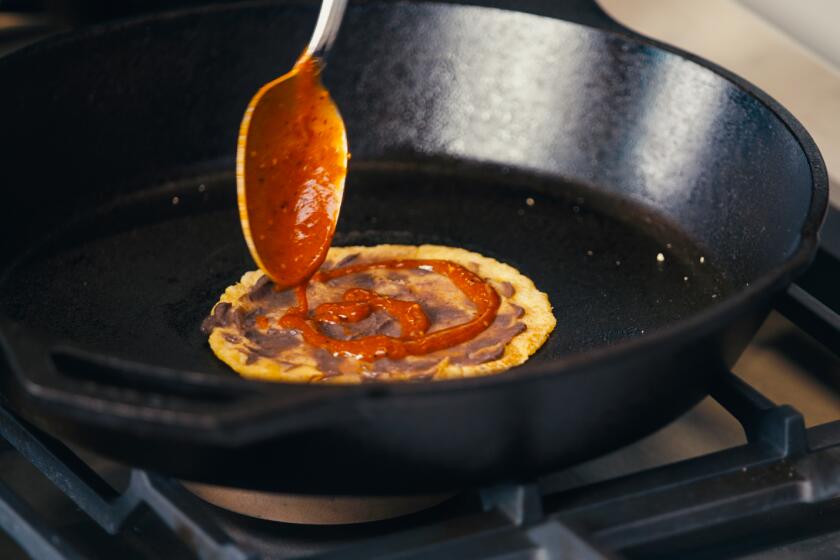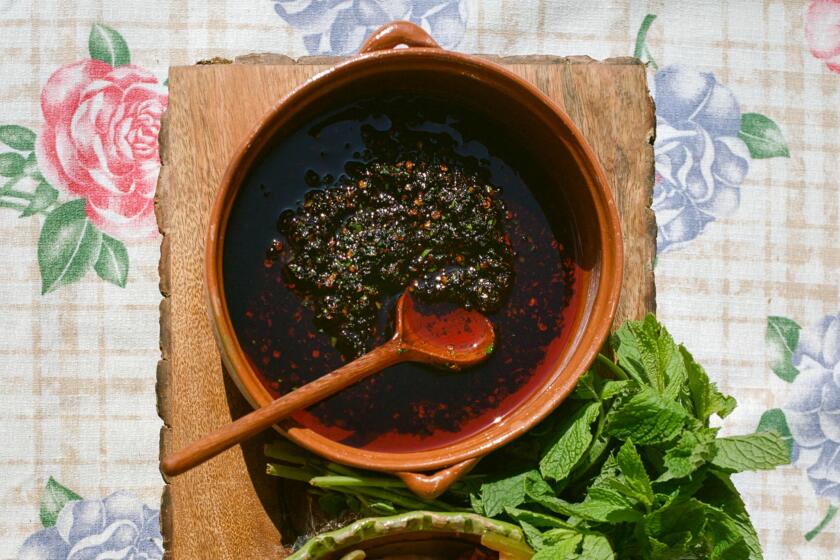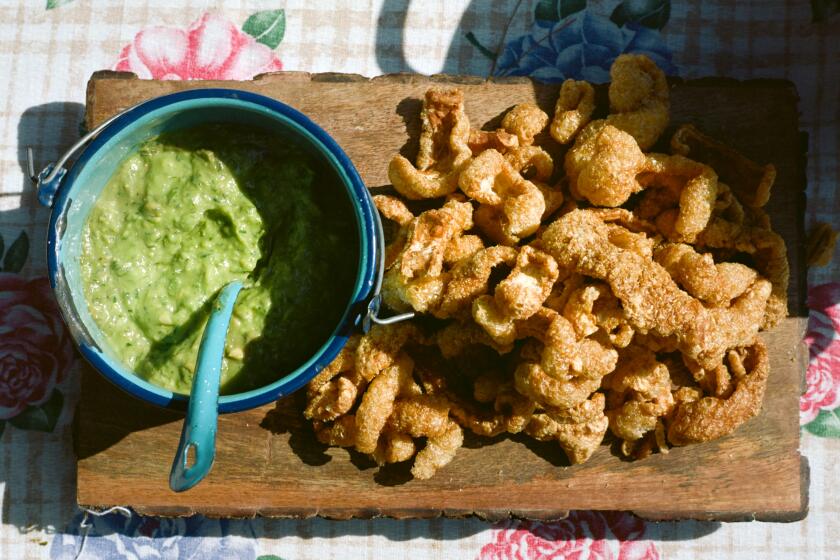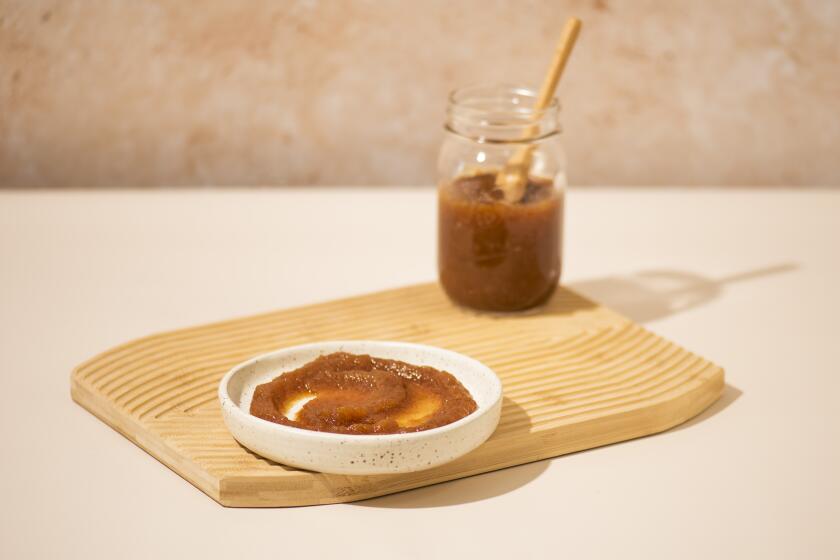Nectarine jam
Once, we made ice cream in the summer because the season demanded it. The grass was high, cows were in milk and orchards heaved with fruit. Today, we buy ice cream from stores because it’s cold and we’re hot.
“It’s wonderful for what it is,” says pastry chef Kimberly Boyce. But when it comes to ice cream, wonderful leaves room for improvement. Boyce is one of the best-regarded cooks in town and famous for her ice cream. For her, nothing matches the satisfaction of making and eating your own ice cream. Follow her lead, and a bowl of homemade ice cream crowned by a rich head of jam is no farther away than a lazy weekend’s cooking.
We no longer rise at dawn to milk cows, but we can still catch the lactic perfume of milk as the cream and vanilla heat on the stove. We may not brave thorns to pluck berries from bushes and vines, but we can still marvel at the sheer intensity of a ripe blackberry, or be stopped in our tracks by the piercing perfume of a nectarine.
These were the things that inspired Boyce to spend the last 10 years perfecting a formula for old-fashioned ice cream. She started at a high school job at a Ben & Jerry’s franchise in Agoura. She loved it, she says, but she never saw the ice cream being made -- it came from Vermont.
Soon, she had her first cooking job, a part-time trial at Spago Hollywood. A steep learning curve started with the realization that ice cream needn’t arrive on trucks. The best is freshly made with local fruit. It should taste of cream and fruit, not sugar. And it is as seasonal as fruit. You don’t choose the flavor. The flavor chooses you. You work with whatever fruit is best.
As she progressed to head pastry chef of Spago Hollywood, then Campanile, turning fruit into ice cream became her particular delight. Last week, she gave us a time-lapse tutorial.
Only the ripest
It began at the Santa Monica farmers market on a Saturday morning, early enough that you could see the fruit for the crowds. It takes a special trip, but fruit for ice cream ideally should come from a farmers market, she says. Supermarket fruit simply lacks the ripeness. If all you have are grocery stores, try the frozen fruit, she recommends. “People will kill me for saying this, but it’s probably better,” she says. “Unlike the fresh fruit, it will probably have been picked dead ripe.”
As she tours the farmers market, she is not buying until she inspects every stall. She is looking for fruit so ripe that it’s begging to be eaten. The boysenberries and nectarines look promising. She sniffs the nectarines to check for scent and responds approvingly to the dappling along the bottom of the fruit. “See these speckles? This means they will be sweeter,” she says. “I don’t know why, but it does.”
But she still doesn’t buy. The next day, she goes to the Hollywood farmers market, where she finds the same vendors, buys the boysenberries and nectarines, along with apricots and Seascape strawberries. All have the ripeness, flavor and acidity needed for the fruit to stand up to the rich ice cream mix.
Many cookbooks say unripe fruit is suitable for cooking, particularly in tarts, but the mention of it makes Boyce wince. Ripeness is essential for ice cream, she says. “Only ripe fruit has the floral essences.” Then there are structural reasons. In a ripe fruit, she says, all the cell structures will be more open, and the fruit and flavor will submit to the blender. If you puree an unripe fruit, its tightly contracted cell walls create gritty, relatively tasteless nubs in the puree.
The exception to the ripe-only rule is fruit intended for roasting. These need to be a bit firm so they don’t dissolve in the pan.
Once she’s in the Times Test Kitchen, the first decision is what kind of ice cream base to make: a French vanilla style, which means that it has eggs in the mix, or a gelato, without eggs.
“I like egg yolk,” she says. “It’s an emulsifier, it adds to the smoothness, gives a smooth, round flavor.”
French vanilla it is.
The next decision concerns cream content. “It’s a matter of playing with the proportions,” she says. “If you have too much cream, your ice cream is going to be too dense. If it has too much milk, it’s usually too light.”
For the two ice creams that are going to be flavored by strawberries and boysenberries, she chooses a lighter base, one part cream to one part milk. “I felt more cream would take away from the fresh fruit flavor. I’m really going for something that tastes like the fruit.”
The first step here is to macerate the fruit in sugar for at least an hour to draw out the moisture and flavor.
“This is really important,” she says. “The more water that can come out of the fruit, the better. You’ll get a better yield in the puree and capture that fresh fruit flavor.” Without macerating, she says, “you’ll be left with a lot of pulp.”
Some fruit toppings call for a richer base. Roasted apricots are one of them. Boyce cranks the cream content to two parts cream for one part milk.
The roasted apricots will bring everything from the acids of a fresh fruit, to the pucker-up tannins of a dried one, to the caramelized richness of the roasting pan. Add nuts and this is the occasion for double cream.
Once the custard is cooked, it needs to be aged in the refrigerator before churning. Giving it 24 hours is ideal, Boyce says. The mixed-up fats and proteins need time to relax and meld with the fruit, vanilla and sugar.
Time passes. The sun sets and rises. The ingredients are copacetic and it’s time to spin the custard in an ice cream maker. Boyce conducts a casual experiment, making each flavor in three different machines: a cheap one and a medium-priced one where the canisters were frozen in a freezer, and a deluxe model with its own built-in freezing element.
In each machine, the basic process is the same. The machine churns the custard, moving it against the frozen sides of the canister, where the mix freezes. But the more deluxe machine shines. It’s a question of icy determination. The more consistently cold the canister, the quicker the custard freezes and the smoother the resulting ice cream. The cheaper the machine, the warmer the canister becomes, and the more water separates that will turn to ice.
To demonstrate this, Boyce pulls a strawberry ice cream made in the cheapest one, draws a spoon through it, and says, “You can even hear the ice. It crunches.”
The slight crackle doesn’t stop everyone from loving it. For those who have cheap machines such as hers, she adds, “it is still a million times better than store-bought.”
One important reason for this is air. During churning, homemade ice cream will take in maybe 5% air. Store-bought ice cream can literally be half air, which is deliberately introduced to lighten the mix. Along with air, other ingredients not found in homemade products will include gum stabilizers, food colorants and a number of nondairy fillers.
The last defining difference between store-bought ice cream and Boyce’s is sugar. Her ice cream tastes of fruit. She uses sugar as spice.
Then she brings out the toppings.
Boyce is a believer in putting whole fruit on ice cream rather than in it. Whole chunks of strawberry become little ice bombs mixed into the custard and frozen, she says. But simmered in some sugar for a quick jam and spooned over an ice cream flavored with a light strawberry puree, the fruit comes through loud and clear.
Classic combinations
There’s no shortcut to learning how to combine fruit and ice cream flavors. But there are a few classic combinations, she says, such as apricot and toasted almonds on vanilla. That said, her favorite technique is to play one fruit for all it’s worth.
To demonstrate the effect, she hands over a demure, light boysenberry ice cream, topped with almost insanely dark, tart boysenberry sauce. It is cry-out good.
Using the toppings this way ekes out every last ounce of fruitiness, she says, including the most ephemeral of all, the bright, fresh acid notes. Using nectarines, Boyce demonstrates how to save these from going up in steam in a jam pan.
First she prepares a nectarine jam, including the skins, which catch and preserve the pleasingly pucker-inducing tannin notes. Finally, just as the jam stops cooking, she tosses in whole slices of fresh fruit. There is only enough heat left to take the edge off the rawness, but so little that it spares the texture and brilliant flavor of a tree-fresh fruit. Put this on a scoop of nectarine ice cream and you would have nectarine in three keys: creamed, jammed and fresh.
As Boyce cooks over two days, enchantment settles over the Test Kitchen. Volunteer tasters, eyes as big as saucers, appear from adjoining offices, each with a story about homemade ice cream from childhood picnics and parties past.
Boyce isn’t surprised by the nostalgia. Making ice cream is an American rite. No other ritual better captures the slow, strange rapture of summer.
Combine the sugar and water until it’s the consistency of wet sand. Cook the mixture over high heat to a light golden caramel, about 10 minutes.
Add half the nectarines. Stir the fruit in a figure-eight pattern with a wooden spoon, keeping the heat as high as possible without splattering juice on your arm. It is important to stir quickly. This will prevent splattering and, most important, the fruit will maintain a fresh flavor, not a cooked caramelized taste.
Cook to a jammy consistency, about 7 minutes. Stir the remaining nectarines into the warm jam.
Get our Cooking newsletter.
Your roundup of inspiring recipes and kitchen tricks.
You may occasionally receive promotional content from the Los Angeles Times.










